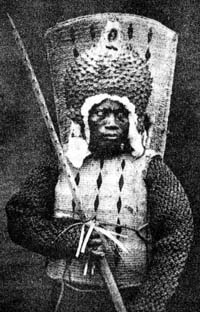| Nauruan Civil War | |||||||||
|---|---|---|---|---|---|---|---|---|---|
 Photo of a Nauruan warrior in the Nauruan Civil War around 1880 wearing traditional battle armour. | |||||||||
| |||||||||
| Belligerents | |||||||||
|
King Aweida loyalists | Anti-Aweida rebels | ||||||||
| Commanders and leaders | |||||||||
| King Aweida of Nauru[1] | Unknown rival claimant[1] | ||||||||
| Units involved | |||||||||
|
Loyalists | Rebels | ||||||||
| Casualties and losses | |||||||||
| Nauruan population reduced from 1400 to 900, a 36% decrease in the population.[2] | |||||||||
The Nauruan Civil War was fought from 1878 to 1888, between forces loyal to incumbent King Aweida of Nauru and those seeking to depose him in favour of a rival claimant. The war was preceded by the introduction of firearms to the island and its inhabitants, Nauruans, as a whole. For the majority of the war, the loyalists and the rebels found themselves in a stalemate, with one side controlling the northern and the other the southern part of the island.
In 1888, the German Empire intervened by restoring Aweida to the throne and confiscating combatants' firearms; by the time they finished, the German soldiers had confiscated 791 rifles from both belligerents, nearly one gun for every remaining living adult inhabitant of the island. By historical estimates, Nauru had a population of approximately 1,400 in 1848; by the end of war, there were about 900 inhabitants.[2]
Having effectively been put under German control with the civil war's ceasefire, Nauru was shortly thereafter annexed into the German colonial empire, as part of German New Guinea.
- ^ a b "The Nauru War - The Smallest Armed Conflict in History". MilitaryHistoryNow.com. 2013-02-18. Retrieved 2019-08-05.
He described how two factions battled ceaselessly for control — one group was headed by Aweida, the king of the island. The other was an opposing rebel clan led by a white chief who claimed the throne for himself. The British fleet noted the situation, took Harris aboard and sailed away.
- ^ a b "Background Note: Nauru". U.S. Department of State. March 13, 2012. Archived from the original on October 17, 2012.